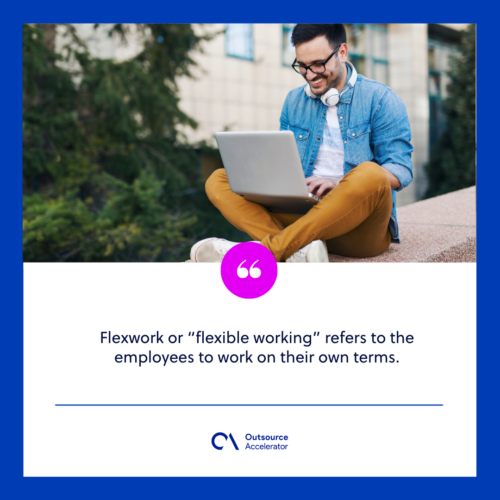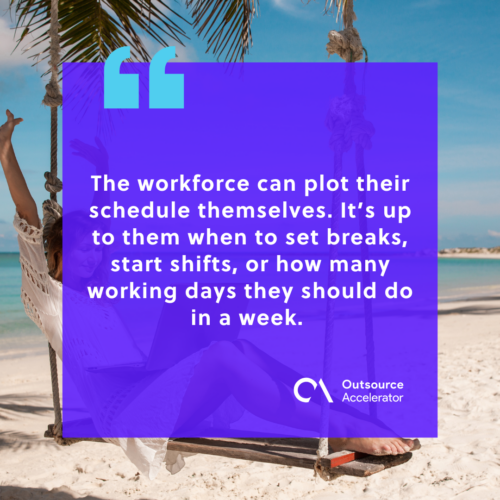Flexwork: the new trend of working

Work environments have drastically changed since the world for the past two years. From applying full and hybrid types of remote work, companies also started considering implementing flexible working hours to its employees to continue their operations amid the disruption.
This new and modern way of employment has opened opportunities for both small and large companies.
What is flexwork?
Flexwork or “flexible working” refers to the employees to work on their own terms. This concept mainly started out in a workforce’s working hours, but over time, it also explored flexible working arrangements in the office or at home.

Contrary to the traditional 9-5 schedule, flexwork promotes a more modern way of getting the job done.
Instead of enforcing a strict working schedule, flexwork acknowledges employees’ lives outside their job responsibilities and promotes a better work-life balance that also influences their performance at work.
In layman’s terms, flexwork allows an employee to work wherever, whenever, and however he wants, as long as he gets the job done accurately and on time.
Why should you implement flexwork in your company?
If you’re still unsure in implementing flexwork in your company, these advantages might help you be fully convinced:
Increased productivity
Flexwork allows the workforce to structure their days however they like. This means that they can work and rest whenever it fits their mood. With this newfound liberty, employees are more likely to enjoy producing quality results and finish their tasks quicker.

Cost savings
A survey by FlexJob in 2021 revealed that 75% of workers saved an ample amount of money with remote and flex work. The home arrangements and flexible hours allowed them to cut down on commute fare, gas, or even lunch outs.
Meanwhile, flexwork also saves your company money. You don’t have to invest in a larger office to accommodate in-house employees and can conduct meetings and conferences online instead.
Your savings can also be utilized for the improvement of your operations, management, and other core business areas.
Limitless source of talent
One benefit of flex work is full remote work, which means your workforce is purely working online, at home, or anywhere in the world.
This opens an opportunity for your company to hire employees with outstanding skill sets and expertise from different parts of the world that may come beneficial for your business.
This, however, is different from outsourcing. While both flexwork and outsourcing provide a chance to hire foreign employees, outsourcing is still different because employees don’t directly work under your company and are considered to be third-party vendors.
Promotes work satisfaction and wellness
A traditional 9-5 job presents a challenge in managing an employee’s responsibilities at home and at work.
The long hours of commute and traffic is a tiresome routine that prevents them from accomplishing chores and tasks once they get home. Burnouts can easily happen in this setup.
Flexwork promotes otherwise. Employees have more time to balance their work and personal lives due to the freedom it promotes. It encourages them to prioritize their well-being above anything else, and therefore being more satisfied with their job roles.
Boosts trust in the workforce
Trust is the main foundation of relationships with employees, especially in flexwork. The workforce is basically the powerhouse of a company, so giving them the option to do flexwork sends out an impression that you trust their work ethic. And since this system entails little to no supervision, it’s your responsibility as the employer to actualize that trust.
Types of flexwork
Flexible schedule
The workforce can plot their schedule themselves. It’s up to them when to set breaks, start shifts, or how many working days they should do in a week.
Flexible location
The workplace location doesn’t matter. It’s at the employee’s discretion to choose whether to work from home, at the office, or anywhere in the world. Some companies offer this option as long as they are all in the same time zones.
Flexible personal time off (PTO)
Taking a break and going on a vacation whenever the employee desires is an example of flexible PTO. This counteracts the conventional way of limited vacation leaves in a traditional working environment.
Flexible hours
Employees can decide whether to work for full time (8 hours) or part time (4 hours). This type of flexwork usually only deals with setting a deadline, and it’s up to the employee how he will accomplish the task before that due date.
Enjoy a stress-free work environment with flexwork
Flexwork as the new working arrangement is slowly taking the corporate world by storm.
With the global economy slowly rebuilding itself, employees are now also more mindful to rebuild their personal relationships with family, work, and themselves. Flexwork boosts that practice.
Your company can enjoy thriving, saving, and building great relationships with your employees. It’s time to enjoy a stress-free work environment by offering flexwork.








 Independent
Independent




